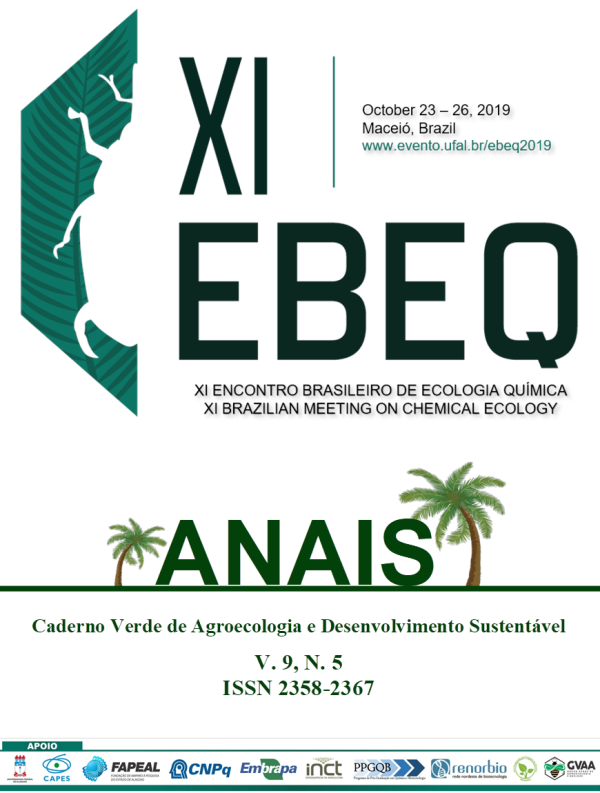IN VITRO STUDY OF A CHEMOSENSORY PROTEIN FROM SEA LOUSE Caligus rogercresseyi
Palavras-chave:
Caligus rogercresseyi, CHEMOSENSORY PROTEINS, FLUORESCENCE-BINDING BIOASSAY.Resumo
The sea louse (Caligus rogercresseyi) is an ectoparasitic copepod that negatively affects salmon farming industry by reducing the health status of fish and producing significant economic losses. An alternative strategy to C. rogercresseyi control friendly with the environment or population´s health has been investigated. Previous information have pointed out that this crustacean has the ability of detecting semiochemicals. The use of semiochemicals as compounds capable of mediate the chemical communication between species could leads to the design of specific and harmless control traps. The olfactory system is the responsible for processing these chemical signals and chemosensory proteins (CSPs) are thought to act as specific carriers of these molecules. Therefore, the objective of this work was to evaluate the recombinant production of a previously identified CSP transcript from C. rogercresseyi (CrogCSP) transcriptome through the cloning, bacterial expression in competent cells and purification of CrogCSP using Ni(II)-based immobilized metal ion affinity chromatography, and the selectivity of this protein against 9 different chemical compounds was tested by fluorescence binding assays. The results indicated that CrogCSP has an apparent molecular mass of ≈10 kDa. Additionally, the protein sequence showed has four cysteine residues and the olfactory specific protein D (OS-D) superfamily domain which is characteristic of the CSPs. Moreover, our results indicated that a polyunsaturated alcohol, a substituted aromatic compound and a monoterpene exhibited dissociation constant (KD) of 2.10, 4.17 and 2.28 µM respectively for the complex formed with CrogCSP, indicating that this chemosensory protein is selective over certain ligands. Likewise, with the knowledge of the olfactory mechanisms of C. rogercresseyi, new methods for controlling sea lice could be incorporated in the near future.Downloads
Publicado
Como Citar
Edição
Seção
Licença
Termo de cessão de direitos autorias
Esta é uma revista de acesso livre, em que, utiliza o termo de cessão seguindo a lei nº 9.610/1998, que altera, atualiza e consolida a legislação sobre direitos autorais no Brasil.
O(s) autor(es) doravante designado(s) CEDENTE, por meio desta, publica a OBRA no Caderno Verde de Agroecologia e Desenvolvimento Sustentável, representada pelo Grupo Verde de Agroecologia e Abelhas (GVAA), estabelecida na Rua Vicente Alves da Silva, 101, Bairro Petrópolis, Cidade de Pombal, Paraíba, Brasil. Caixa Postal 54 CEP 58840-000 doravante designada CESSIONÁRIA, nas condições descritas a seguir:
O CEDENTE declara que é (são) autor(es) e titular(es) da propriedade dos direitos autorais da OBRA submetida.
O CEDENTE declara que a OBRA não infringe direitos autorais e/ou outros direitos de propriedade de terceiros, que a divulgação de imagens (caso as mesmas existam) foi autorizada e que assume integral responsabilidade moral e/ou patrimonial, pelo seu conteúdo, perante terceiros.
O CEDENTE mantêm os direitos autorais e concedem à revista o direito de divulgação da OBRA, com o trabalho simultaneamente licenciado sob a Licença Creative Commons do tipo atribuição CC-BY.
O CEDENTE têm autorização para distribuição não-exclusiva da versão do trabalho publicada nesta revista.
O CEDENTE têm permissão e são estimulados a publicar e distribuir seu trabalho online (ex.: em repositórios institucionais ou na sua página pessoal) a qualquer ponto antes ou durante o processo editorial, já que isso pode gerar alterações produtivas, bem como aumentar o impacto e a citação do trabalho publicado.










